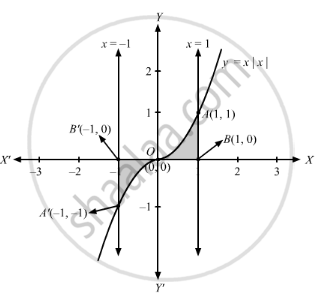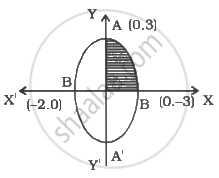Advertisements
Advertisements
Question
The area bounded by the curve y = x |x| and the ordinates x = −1 and x = 1 is given by
Options
0
- \[\frac{1}{3}\]
- \[\frac{2}{3}\]
- \[\frac{4}{3}\]
Solution

The given equation of the curve is
\[y = x \left| x \right|\]
\[ \Rightarrow y = \begin{cases} x^2 & x \geq 0\\ - x^2 & x < 0 \end{cases}\]
\[\text{ Now, solving }x = 1\text{ and }y = x\left| x \right|\text{ we get }\]
\[x = 1 \Rightarrow y = 1 \]
\[ \Rightarrow A\left( 1, 1 \right)\text{ is point of intersection of the cuve }y = x\left| x \right|\text{ and }x = 1\]
\[\text{ Also, solving }x = - 1\text{ and }y = x\left| x \right|\text{ we get }\]
\[x = - 1 \Rightarrow y = - 1\]
\[ \Rightarrow A'\left( - 1, - 1 \right)\text{ is point of intersection of the cuve }y = x\left| x \right|\text{ and }x = - 1\]
\[\text{ If P}\left( x, y_1 \right) , x > 0\text{ is a point on }y = x \left| x \right|\text{ then }y_1 > 0 \Rightarrow \left| y_1 \right| = y_1 \]
\[ \text{ And Q}\left( x, y_2 \right) , x < 0\text{ is a point on }y = x \left| x \right|\text{ then }y_2 < 0 \Rightarrow \left| y_2 \right| = - y_2 \]
\[\text{ Required area }= \int_{- 1}^0 \left| y_2 \right| dx + \int_0^1 \left| y_1 \right| dx\]
\[ = \int_{- 1}^0 - y_2 dx + \int_0^1 y_1 dx\]
\[ = \int_{- 1}^0 - \left( - x^2 \right) dx + \int_0^1 x^2 dx\]
\[ = \int_{- 1}^0 x^2 dx + \int_0^1 x^2 dx\]
\[ = \left[ \frac{x^3}{3} \right]_{- 1}^0 + \left[ \frac{x^3}{3} \right]_0^1 \]
\[ = \left[ 0 - \frac{\left( - 1 \right)}{3}^3 \right] + \left( \frac{1^3}{3} - 0 \right)\]
\[ = \frac{1}{3} + \frac{1}{3}\]
\[ = \frac{2}{3}\text{ sq units }\]
APPEARS IN
RELATED QUESTIONS
triangle bounded by the lines y = 0, y = x and x = 4 is revolved about the X-axis. Find the volume of the solid of revolution.
Using the method of integration, find the area of the triangular region whose vertices are (2, -2), (4, 3) and (1, 2).
Area bounded by the curve y = x3, the x-axis and the ordinates x = –2 and x = 1 is ______.
Find the equation of a curve passing through the point (0, 2), given that the sum of the coordinates of any point on the curve exceeds the slope of the tangent to the curve at that point by 5.
Find the area of ellipse `x^2/1 + y^2/4 = 1`
Sketch the graph of y = |x + 4|. Using integration, find the area of the region bounded by the curve y = |x + 4| and x = –6 and x = 0.
Find the area lying above the x-axis and under the parabola y = 4x − x2.
Draw a rough sketch to indicate the region bounded between the curve y2 = 4x and the line x = 3. Also, find the area of this region.
Make a rough sketch of the graph of the function y = 4 − x2, 0 ≤ x ≤ 2 and determine the area enclosed by the curve, the x-axis and the lines x = 0 and x = 2.
Sketch the graph of y = \[\sqrt{x + 1}\] in [0, 4] and determine the area of the region enclosed by the curve, the x-axis and the lines x = 0, x = 4.
Find the area bounded by the ellipse \[\frac{x^2}{a^2} + \frac{y^2}{b^2} = 1\] and the ordinates x = ae and x = 0, where b2 = a2 (1 − e2) and e < 1.
Find the area of the minor segment of the circle \[x^2 + y^2 = a^2\] cut off by the line \[x = \frac{a}{2}\]
Find the area of the region common to the parabolas 4y2 = 9x and 3x2 = 16y.
Find the area of the region \[\left\{ \left( x, y \right): \frac{x^2}{a^2} + \frac{y^2}{b^2} \leq 1 \leq \frac{x}{a} + \frac{y}{b} \right\}\]
Using integration, find the area of the triangular region, the equations of whose sides are y = 2x + 1, y = 3x+ 1 and x = 4.
Find the area common to the circle x2 + y2 = 16 a2 and the parabola y2 = 6 ax.
OR
Find the area of the region {(x, y) : y2 ≤ 6ax} and {(x, y) : x2 + y2 ≤ 16a2}.
Find the area enclosed by the parabolas y = 5x2 and y = 2x2 + 9.
Find the area of the region bounded by \[y = \sqrt{x}\] and y = x.
Using the method of integration, find the area of the region bounded by the following lines:
3x − y − 3 = 0, 2x + y − 12 = 0, x − 2y − 1 = 0.
In what ratio does the x-axis divide the area of the region bounded by the parabolas y = 4x − x2 and y = x2− x?
Find the area of the region between the parabola x = 4y − y2 and the line x = 2y − 3.
If the area above the x-axis, bounded by the curves y = 2kx and x = 0, and x = 2 is \[\frac{3}{\log_e 2}\], then the value of k is __________ .
The area bounded by y = 2 − x2 and x + y = 0 is _________ .
The ratio of the areas between the curves y = cos x and y = cos 2x and x-axis from x = 0 to x = π/3 is ________ .
Find the coordinates of a point of the parabola y = x2 + 7x + 2 which is closest to the straight line y = 3x − 3.
Find the equation of the standard ellipse, taking its axes as the coordinate axes, whose minor axis is equal to the distance between the foci and whose length of the latus rectum is 10. Also, find its eccentricity.
Find the area of the region bound by the curves y = 6x – x2 and y = x2 – 2x
Find the area bounded by the lines y = 4x + 5, y = 5 – x and 4y = x + 5.
The area of the region bounded by the circle x2 + y2 = 1 is ______.
The curve x = t2 + t + 1,y = t2 – t + 1 represents
Area of the region bounded by the curve `y^2 = 4x`, `y`-axis and the line `y` = 3 is:
Find the area of the region bounded by `y^2 = 9x, x = 2, x = 4` and the `x`-axis in the first quadrant.
Find the area of the region bounded by the ellipse `x^2/4 + y^2/9` = 1.
The area bounded by the curve `y = x|x|`, `x`-axis and the ordinate `x` = – 1 and `x` = 1 is given by
Area of figure bounded by straight lines x = 0, x = 2 and the curves y = 2x, y = 2x – x2 is ______.
Find the area of the minor segment of the circle x2 + y2 = 4 cut off by the line x = 1, using integration.
Using integration, find the area of the region bounded by y = mx (m > 0), x = 1, x = 2 and the X-axis.
Using integration, find the area of the region bounded by the curve y2 = 4x and x2 = 4y.
